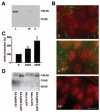Gap junction protein Cx37 interacts with endothelial nitric oxide synthase in endothelial cells
- PMID: 20081116
- PMCID: PMC2930827
- DOI: 10.1161/ATVBAHA.109.200816
Gap junction protein Cx37 interacts with endothelial nitric oxide synthase in endothelial cells
Abstract
Objective: The gap junction protein connexin37 (Cx37) plays an important role in cell-cell communication in the vasculature. A C1019T Cx37 gene polymorphism, encoding a P319S substitution in the regulatory C terminus of Cx37 (Cx37CT), correlates with arterial stenosis and myocardial infarction in humans. This study was designed to identify potential binding partners for Cx37CT and to determine whether the polymorphism modified this interaction.
Methods and results: Using a high-throughput phage display, we retrieved 2 binding motifs for Cx37CT: WHK ... [K,R]XP ... and FHK ... [K,R]XXP ... , the first being more common for Cx37CT-319P and the second more common for Cx37CT-319S. One of the peptides (WHRTPRLPPPVP) showed 77.7% homology with residues 843 to 854 of endothelial nitric oxide synthase (eNOS). In vitro binding of this peptide or of the homologous eNOS sequence to both Cx37CT isoforms was confirmed by cross-linking and surface plasmon resonance. Electrophysiological analysis of Cx37 single channel activity in transfected N2a cells showed that eNOS-like and eNOS(843-854) increased the frequency of events with conductances higher than 300 pS. We demonstrated that eNOS coimmunoprecipitated with Cx37 in a mouse endothelial cell (EC) line (bEnd.3), human primary ECs, and a human EC line transfected with Cx37-319P or Cx37-319S. Cx37 and eNOS colocalized at EC membranes. Moreover, a dose-dependent increase in nitric oxide production was observed in ECs treated with Cx37 antisense.
Conclusions: Overall, our data show for the first time a functional and specific interaction between eNOS and Cx37. This interaction may be relevant for the control of vascular physiology both in health and in disease.
Figures





Similar articles
-
Unexpected role for the human Cx37 C1019T polymorphism in tumour cell proliferation.Carcinogenesis. 2010 Nov;31(11):1922-31. doi: 10.1093/carcin/bgq170. Epub 2010 Aug 12. Carcinogenesis. 2010. PMID: 20705954
-
Loss of connexin40 is associated with decreased endothelium-dependent relaxations and eNOS levels in the mouse aorta.Am J Physiol Heart Circ Physiol. 2010 Nov;299(5):H1365-73. doi: 10.1152/ajpheart.00029.2010. Epub 2010 Aug 27. Am J Physiol Heart Circ Physiol. 2010. PMID: 20802140
-
NO Augments Endothelial Reactivity by Reducing Myoendothelial Calcium Signal Spreading: A Novel Role for Cx37 (Connexin 37) and the Protein Tyrosine Phosphatase SHP-2.Arterioscler Thromb Vasc Biol. 2017 Dec;37(12):2280-2290. doi: 10.1161/ATVBAHA.117.309913. Epub 2017 Oct 12. Arterioscler Thromb Vasc Biol. 2017. PMID: 29025706
-
Interaction between nitric oxide signaling and gap junctions: effects on vascular function.Biochim Biophys Acta. 2012 Aug;1818(8):1895-902. doi: 10.1016/j.bbamem.2011.07.031. Epub 2011 Jul 28. Biochim Biophys Acta. 2012. PMID: 21835160 Free PMC article. Review.
-
Connexin37: a potential modifier gene of inflammatory disease.J Mol Med (Berl). 2007 Aug;85(8):787-95. doi: 10.1007/s00109-007-0169-2. Epub 2007 Feb 22. J Mol Med (Berl). 2007. PMID: 17318613 Review.
Cited by
-
Endothelial connexins in vascular function.Vasc Biol. 2019 Nov 7;1(1):H117-H124. doi: 10.1530/VB-19-0015. eCollection 2019. Vasc Biol. 2019. PMID: 32923963 Free PMC article. Review.
-
Carboxy terminus and pore-forming domain properties specific to Cx37 are necessary for Cx37-mediated suppression of insulinoma cell proliferation.Am J Physiol Cell Physiol. 2013 Dec 15;305(12):C1246-56. doi: 10.1152/ajpcell.00159.2013. Epub 2013 Oct 16. Am J Physiol Cell Physiol. 2013. PMID: 24133065 Free PMC article.
-
GJA4/Connexin 37 Mutations Correlate with Secondary Lymphedema Following Surgery in Breast Cancer Patients.Biomedicines. 2018 Feb 22;6(1):23. doi: 10.3390/biomedicines6010023. Biomedicines. 2018. PMID: 29470392 Free PMC article.
-
Connexins and Pannexins in Vascular Function and Disease.Int J Mol Sci. 2018 Jun 5;19(6):1663. doi: 10.3390/ijms19061663. Int J Mol Sci. 2018. PMID: 29874791 Free PMC article. Review.
-
Lipopolysaccharide exposure during pregnancy leads to aortic dysfunction in offspring rats.PLoS One. 2014 Jul 15;9(7):e102273. doi: 10.1371/journal.pone.0102273. eCollection 2014. PLoS One. 2014. PMID: 25025169 Free PMC article.
References
-
- Chanson M, Kwak BR. Connexin37: a potential modifier gene of inflammatory disease. J Mol Med. 2007;85:787–795. - PubMed
-
- Wong CW, Christen T, Roth I, Chadjichristos CE, Derouette JP, Foglia BF, Chanson M, Goodenough DA, Kwak BR. Connexin37 protects against atherosclerosis by regulating monocyte adhesion. Nat Med. 2006;12:950–954. - PubMed
-
- Kwak BR, Mulhaupt F, Veillard N, Gros DB, Mach F. Altered pattern of vascular connexin expression in atherosclerotic plaques. Arterioscler Thromb Vasc Biol. 2002;22:225–230. - PubMed
-
- Yamada Y, Izawa H, Ichiwara S, Takatsu F, Ishihara H, Hirayama H, Sone T, Tanaka M, Yokota M. Prediction of the risk of myocardial infarction from polymorphisms in candidate genes. N Engl J Med. 2002;347:1916–1923. - PubMed
-
- Listi F, Candore G, Lio D, Russo M, Colonna-Romano G, Caruso M, Hoffmann E, Caruso C. Association between C1019T polymorphism of connexin37 and acute myocardial infarction: study in patients from Sicily. Int J Cardiol. 2005;102:269–271. - PubMed
Publication types
MeSH terms
Substances
Grants and funding
LinkOut - more resources
Full Text Sources
Other Literature Sources
Miscellaneous

